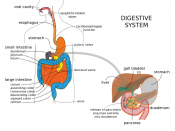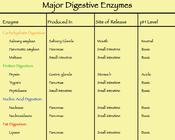Saliva is secreted from the salivary glands. The saliva contains enzymes such as Ptyalin, which starts sugar digestion. The enzymes also provide lubrication to help in the chewing and swallowing of the food. The food then goes down the esophagus and into the stomach, where the next step of digestion takes place.
In the stomach, a mixture of hydrochloric acid and Pepsin, which is secreted by the stomach wall, liquefies the food. At the same time, a substance called intrinsic factor binds Vitamin B in food and various gastric enzymes, such as Pepsin (which begins protein digestion), which are secreted by the stomach wall. Secretions of mucus protect the stomach from its digestive enzymes. The food is then mixed in the stomach, turning it into chyme(digested food). The muscular pumping motion called peristalsis churns the chyme around.
The chyme then passes through the pyloric valve by peristalsis to the first portion of the small intestine, the duodenum.
The duodenum is where most of the chemical digestion takes place. Here, bile from the gallbladder and enzymes from the pancreas and intestinal walls combine with the chyme to begin the final part of digestion.
Bile liquid is created in the liver, and stored in the gallbladder. Bile aids in the mechanical digestion of fat. The pancreas and gland cells of the small intestine secrete digestive enzymes that chemically break down complex food molecules into simpler ones. These enzymes include trypsin for protein digestion, amylase for carbohydrate digestion, and lipase for fat digestion. When the food passes through the duodenum, the digestion is complete.
From the duodenum, the chyme passes to the jejunum and ileum, where tiny finger-like objects called villi, cover the walls. These villi start the absorption of food. During the absorption, food molecules enter the blood stream through the...


